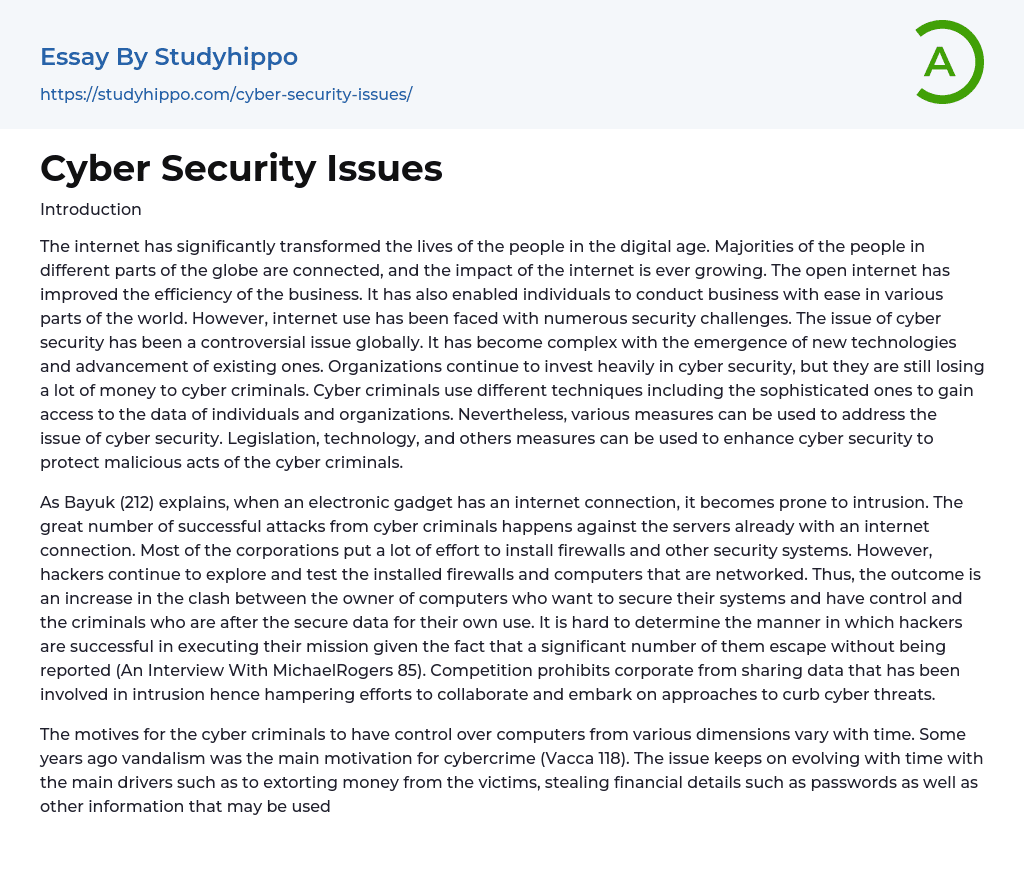Introduction
The internet has transformed the lives of individuals in the digital age, connecting people worldwide and continuously expanding its influence. Businesses have reaped advantages from the accessible internet, achieving greater effectiveness, while individuals can now effortlessly participate in global commerce.
Despite the numerous security challenges, cyber security remains a persistent global issue that affects internet usage. The problem has become more complex due to the rise of new technologies and advancements, despite organizations investing heavily in cyber security. They still suffer significant financial losses caused by cyber criminals who employ various techniques, including sophisticated ones, to infiltrate individuals' and organizations' data.
Various methods can be utilized to address cyber security concerns, such as enacting laws, employing technology, and implementing additional measures. These strategies serve to bolster cyber security efforts and provide protection against malicio
...us activities carried out by cyber criminals. As stated by Bayuk (212), any internet-connected electronic device is susceptible to intrusion. Cyber criminals primarily focus on servers with an active internet connection, leading to a significant number of successful attacks.
Most corporations invest heavily in installing firewalls and other security systems, but hackers persistently attempt to breach these defenses and target networked computers. This leads to a growing conflict between computer owners who seek security and control and criminals who seek access to valuable data for personal gain. The success rate of hackers remains difficult to ascertain as many of them go undetected and unreported (An Interview With MichaelRogers 85).
Competition impedes corporate collaboration and cybersecurity initiatives by obstructing the exchange of intrusion-related data. The motives driving cyber criminals to gain control over computers change over time. Previously, vandalism was the main incentive for engaging in cybercrime
(Vacca 118). However, these motivations have expanded to encompass extorting money, pilfering financial information such as passwords, and obtaining other data for the purpose of committing cybercrime. As new technologies emerge, the methods employed to access online information also progress.
The prevalence of advanced techniques used by hackers has increased in comparison to a decade ago. These sophisticated methods enable criminals to surpass security measures, such as anti-malware, which individuals and organizations rely on for data protection. Various groups, including professional organizations, state-sponsored groups, and political hacktivists, employ these advanced technologies that exceed the knowledge of security personnel. Consequently, cybercrime continues to escalate as hackers provide their services in exchange for financial profit. At present, tracking malware proves challenging since it is frequently tailored to acquire valuable information for monetary motives (An Interview With Michael Rogers 83).
Organized crimes often receive better funding than the security operations of their victims, which contributes to their success. Although IT systems are developed by numerous professionals, these systems are constantly targeted by attacks. This is because the design of these systems incorporates various elements, including applications, network components, and hardware, which increases the likelihood of introducing human errors or vulnerabilities (Spalevic 687). Consequently, even though organizations implement defense measures to protect their systems, they remain susceptible to attacks. Furthermore, organizations are now expected to conduct their activities with greater transparency compared to previous times.
Employees in various units are increasingly requesting access to corporate networks using their personal communication devices. The rise of smartphones has increased connectivity but also introduced additional cyber security risks. Hackers can easily exploit these devices, enabling malware to infiltrate the corporate networks. Personally, I believe that
technological advancements are making cyber security more complicated. However, there are several approaches available to mitigate cyber threats.
A suggested method to detect potential vulnerabilities involves undertaking formal validation and testing. This includes assessing the system for any exploitable weaknesses (Vacca 124). To ensure the system's validity, functional testing can be conducted. Additionally, penetration testing can evaluate the system's capacity to withstand specific attacks, along with resilience testing.
However, formal validation alone is insufficient for interconnected systems since they cannot be fully tested. To mitigate cyber threats, diversifying rather than standardizing is an alternative approach (Bayuk 213). Malware can infect these systems and a uniform design structure makes them highly vulnerable.
Implementing diverse cyber systems makes it challenging for attackers to exploit vulnerabilities. Many organizations often have homogenous systems, which increases their susceptibility to vulnerabilities and faults. By implementing redundant systems differently from the primary system, they become more resilient to cyber attacks. Spalevic (692) argues that organizations should adopt heterogeneous implementations to mitigate the risk of attacks.
The approach would enhance the security of corporate networks by minimizing vulnerability to attackers.
Conclusion
Safeguarding digital data is crucial for organizations. In the modern era, organizations have made significant investments in cyber security to protect their information from unauthorized individuals. However, despite these investments, attackers still manage to access protected information. One factor contributing to this is the diverse motives driving criminals to engage in cyber crime.
In addition, criminals are able to develop advanced techniques because of the emergence of new technologies. These techniques constantly evolve, catching most companies off-guard and resulting in their important information falling into the wrong hands. However, there are various approaches
that can be used to prevent cyber threats. Employing strategies like formal validation and testing, as well as diversity over testing, can help address the issue of cyber threat.
Work Cited
- "An Interview With Michael S. Rogers." JFQ: Joint Force Quarterly 80 (2016): 78-85. Academic Search Premier. Web. 6 Apr. 2016.
- Bayuk, J.
L. Cyber security policy guidebook. Hoboken, N.J: Wiley, 2012.
Business Source Complete. Web. 6 Apr. 2016. Vacca, J. R.
Cyber security and IT infrastructure protection is a book published in 2013 by Syngress in Amsterdam.




